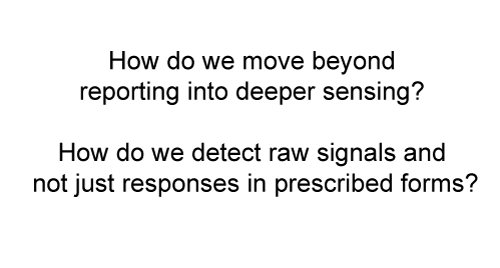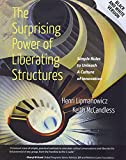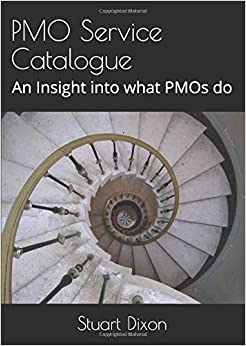You can find all our articles and past events
Free Articles | Inside PMO | PMO Conference | PMO Book Shelf
Adventures of the Self-Aware PMO in an Octopus’ Garden
It is not because things are difficult that we do not dare; it is because we do not dare that they are difficult.
Lucius Annaeus Seneca
Fifty years ago this month, in Jersey, a recently qualified butcher: 19-year-old Ian Waterman was ill with a mystery virus. In a few days, Ian lost all sense of his body. Yet, he wasn’t paralysed.
A friend who visited him described how he struggled to put a spoon in his mouth. The arm and hand would move past his neck and far over his shoulder. Ian had lost all sense of where his limbs were, what his body was up to from the neck down.
The virus had destroyed all the sensory nerves responsible for touch and conveying information about muscle and joint position. Having an awareness of your limbs has been described as our sixth sense. It is called “proprioception”, by analogy with “perception”.
Why Our Sixth Sense Matters
 Twenty-five years later, Ian had worked out how to control his movements without an intimate sense of what his body was up to. Essentially, he started to operate his body, something like someone operating an earthmover.
Twenty-five years later, Ian had worked out how to control his movements without an intimate sense of what his body was up to. Essentially, he started to operate his body, something like someone operating an earthmover.
He had started teaching other sufferers of this very rare illness, now called the acute sensory neuropathy syndrome, how to avoid being trapped in bed despite not being paralysed. The BBC did a Horizon documentary about him at the time.
Ian Waterman has continued to help others live without proprioception. He was interviewed more recently by Jackie Higgins as part of the research supporting her fascinating book “Sentient: what animals reveal about our senses.”
Jackie wondered whether Ian’s experience of “operating” his body felt in any way like an octopus, whose central brain has no fine control over the arms. Each arm is its own brain, and they do what they like, unless the central instruction is to flee, when they swim in perfect coordination.
The image of an octopus and its many brains got me thinking about the coordination problem in organisations. Are there equivalent patterns in things that are not organisms but assemblages? Is there a level of complexity in organisations that begins to cry out for the equivalent of proprioception in bodies?
For instance, small companies, start-ups, and single team organisations do not need a PMO. As size and complexity increase, some functions and procedures of an organisation separate from where they were embedded initially and, in many cases, they come together again in a PMO. Their joint focus is to streamline and assure the delivery of change – those outputs and outcomes that are not part of business as usual.
Rather than defining a PMO, we can talk about what they do or what they could do.
In his book “PMO Service Catalogue”, Stuart Dixon itemises 25 service areas that PMOs can use to develop their own Service Catalogue, one that fits their organisation. Then, for each service area, Stuart groups the possible services into three main activity types:
• Design
• Operate
• Monitor
This has implications depending on where in the organisation a particular PMO sits: Portfolio, Programme, Project, or something else.
I thought of Stuart’s work because ‘Operate’ and ‘Monitor’ remind me of the proprioceptive functions (services?) performed by various nerve networks in live organisms. PMOs may be able to see dead projects, but that’s not the sixth sense we are talking about.
I don’t want to stretch the analogy too far, but I wonder if exploring what would make for a more proprioceptive PMO would lead us to valuable and practical improvements.
The Challenge for PMOs
So, the challenge is to find ways to be more aware of what is really happening: with teams, with people, with deliverables, with work in progress. It may be that the standard “sensing mechanisms” are a bit stiff, clogged up, and unresponsive. Maybe the reporting has become formulaic, a chore for the writers, a bore for the readers. Perhaps ‘what truly matters’ gets said unofficially, among trusted contacts, or not at all.
That’s what I mean by ‘the challenge’; it’s not easy because, on the one hand, there’s not supposed to be a problem, and on the other hand, we don’t have any easy way of overcoming the problem since we are doing things by the book.
Do you recognise the problem but feel it’s always been like that in every PMO you’ve worked in? Not the worst pain on your list? If so, I sympathise: I, too, have let it go in the past. In that case, read no further. There: you’ve saved a little time.
However, if you feel that there is value for the taking if you only knew how to unblock the pipes, read on. What follows is not a magic recipe, a sure-fire win in 7 steps. There is no Father Christmas. Yet, it is all within your circle of influence. All that value you vaguely glimpse is within your reach, admittedly at the end of a long road.
It won’t take you years to do this, but it will always be a work in progress – adapting to your changing context, two steps forward, one step back. It took Ian Waterman years to learn how to operate his body, unable to rely on what is supposed to work but doesn’t. His darkest period was when he realised what he’d lost and wished the ceiling would crash down on his hospital bed, where he lay immobile. Not because he couldn’t move, but because he had no idea how to direct the movements that he had the power to execute—frightening chaos. A more self-aware PMO, enabling a more self-aware organisation, is a piece of cake compared to that.
Where to start? How do we move beyond reporting into deeper sensing? How do we detect raw signals and not just responses in prescribed forms?

There are many ways, and the best options are those suited to your context. It is a question of learning by doing, and the process can be accelerated by partnering with a coach or mentor with experience in your terrain.
 You could try one or more of a family of interventions called Liberating Structures to get going. You would not need any external help as long as you invite all your stakeholders to participate and value their contributions. There is a lot of information out there about how people have applied it. Still, it is best to start with the original book: “The Surprising Power of Liberating Structures” by Henri Lipmanowicz and Keith McCandless (2013).
You could try one or more of a family of interventions called Liberating Structures to get going. You would not need any external help as long as you invite all your stakeholders to participate and value their contributions. There is a lot of information out there about how people have applied it. Still, it is best to start with the original book: “The Surprising Power of Liberating Structures” by Henri Lipmanowicz and Keith McCandless (2013).
Liberating Structures have been shown to work in many settings, industries, countries, group sizes, single meetings and large transformation initiatives. They employ simple rules, simply stated and reassuringly specific. They are easy to learn, it is all in the doing, and everyone at every level can use them. Liberating Structures are methods for a purpose: to improve performance. Allow me to suggest that they can also serve our goal: to revitalise our sense-and-respond reflexes so that we can plan and refine actions much better.
This is why these toys belong in an octopus’ garden. Let’s swim into that garden for a moment.
What can we learn from the octopus?
“Some sort of mixture of localized and top-down control might be operating. […]” They asked whether an octopus could learn to guide a single arm along a maze-like path to a specific place in order to obtain food. The task was set up in such a way that the arm’s own chemical sensors would not suffice to guide it to the food; the arm would have to leave the water at one point to reach the target location. But the maze walls were transparent, so the target location could be seen. The octopus would have to guide an arm through the maze with its eyes.

It took a long while for the octopuses to learn to do this, but in the end, nearly all the octopuses that were tested succeeded. The eyes can guide the arms. At the same time, the paper also noted that when octopuses are doing well with this task, the arm that’s finding the food appears to do its own local exploration as it goes, crawling and feeling around. So it seems that two forms of control are working in tandem: there is central control of the arm’s overall path, via the eyes, combined with fine-tuning of the search by the arm itself.”
This passage (pp. 68-69) from “Other Minds – The Octopus and the Evolution of Intelligent Life” by Peter Godfrey-Smith (2016) suggests that (by analogy) we can transcend the usual organisational tug of war between command-and-control approaches and autonomous-distributed approaches to getting things done. It’s not either/or; it’s both. In transcending this debate, we can reach a higher level of performance.
Suppose we liken the average organisation with its inevitable silos to an octopus and its very intelligent arms. In that case, we could stretch the analogy to the PMO being the eye of the octopus. Not the eye of the tiger; that’s a different song.
We can learn the self-awareness we need as an organisation to cope with the accelerating stresses and upheavals in the world around us. Because we still need to function right here, right now.
Back to Liberating Structures (LS), then. LS can be thought of as a language made of 33 words, each of them a group intervention. Sometimes, just one structure (one word) is all you need to make a small change to big effect. Over the years of using them, I thought that a big part of their effectiveness was the physical proximity of the group. Then, attending a webinar one night over the pandemic, the organiser casually dropped “1-2-4-All” to figure out reactions to the presentation and next steps. It worked really well, totally online, with strangers. Why am I surprised?
Sometimes, you have to sequence the structures for more extensive or more complex changes into what Lipmanowicz and McCandless call “strings”. This is done so that various aspects of sensing and innovation are brought to bear on the problem. It can be a lot of fun to design and watch unfold together.
A String of Solutions
Here’s a description of one string I’ve designed that may work to increase our organisational proprioception – to make a PMO and its organisation more self-aware by repeated application. You will need to refer to Lipmanowicz and McCandless for the details or check out the website before you can use these LS – here, I only give the reasoning for pulling them together into a string.
1. What, So What, Now What?
Start with ‘W3’ to explore what you know about the probe/sense/respond situation in your context.
After a shared experience, ask, “WHAT? What happened? What did you notice? What facts or observations stood out?” Then, after all the salient observations have been collected, ask, “SO WHAT? Why is that important? What patterns or conclusions are emerging? What hypotheses can you make?” Then, after sense-making is over, ask. “NOW WHAT? What actions make sense?”
A related technique that is really useful in this context is Chris Argyris’ Ladder of Inference, later popularised by Peter Senge. Again, easy to find online.
2. TRIZ
Wicked fun. A little creative destruction to create headroom in your packed calendar.
A 3-step process, where you ask the group, first: “Make a list of all you can do to make sure that you achieve the worst result imaginable with respect to your strategy or objective.”
Then, “Go down this list item by item and ask yourselves, ‘Is there anything that we are currently doing that in any way resembles this item?’ Be brutally honest to make a second list of all your counterproductive activities, programs, and procedures.”
Finally, “Go through the items on your second list and decide what first steps will help you stop what you know creates undesirable results?”
3. 15% Solutions
The legendary W Edwards Deming found in his research that people have about 15% control over their work situations. The rest is outside their circle of direct influence: structure, systems and culture. This is the great weakness of formal planning, which attempts to stage a frontal attack on the 100%, only to find the 85% triggered to react and defend the status quo.
So, in connection with their personal challenge or their group’s challenge, ask, “What is your 15%? Where do you have discretion and freedom to act? What can you do without more resources or authority?”
I have personally found that last question to be one of the most liberating ever.
4. Min Specs
As the ‘To Do’ list grows, this LS allows you to prune it right back to the essentials. Min Specs will enable you to focus or redirect resources and energies where it matters.
In the context of a challenging activity or a new initiative, invite the participants first to generate the entire list of all the dos and don’ts that they should pay attention to to achieve a successful outcome. This is the list of maximum specifications (Max Specs).
After the list of Max Specs has been developed, ask the participants to reduce it to the absolute minimum needed to achieve their purpose. Invite them to sift through the list one item at a time and eliminate every rule that gets a positive answer to the question, “If we broke or ignored this rule, could we still achieve our purpose?”
5. 1-2-4-All
Use it first, last or in between. Anytime you need to include everyone regardless of how large the group is while allowing individuals to retain ownership of the generated questions, ideas and suggestions.
Ask a question in response to the presentation of an issue, or about a problem to resolve or a proposal put forward (e.g., What opportunities do YOU see for making progress on this challenge? How would you handle this situation? What ideas actions do you recommend?)
Start alone, then in pairs, then foursomes, and finally as a whole group.
Liz Rykert has popularised a variant of the exercise where we go from groups of 4 to groups of 8 with consensus in mind. She calls this “Octopus!”
The point of the exercise is to find better ways to engage with the parts, siloes, projects, teams, and areas with whom you do not have a lively and reliable ongoing conversation.
Therefore, the starting line is to invite as many of the ‘right people’ as possible to participate in these Liberating Structures. You know your context and your mission. You know who they are.
The example ‘string’ I described above can be repeated, it can be changed, and it can be stopped. Make sure that you decide how you will know that you have reached the next plateau in your organisation’s climb to excellence as part of the exercise.
What Next?
We started by exploring the value of proprioception and how that sixth sense could apply to organisations generally and their PMOs specifically.
We then explored the promise of LS to build those sensing pathways of communication that make a difference.
I hope you are feeling daring and ready to try something good. I’d be interested to hear from those who’ve already come across and tried LS. What did you like best? What didn’t seem to make a difference? What questions come to mind as you get to the end of your reading? And thanks for staying with me!
I’d be happy to re-visit and expand the topic to follow up on questions or queries via Linkedin.
By the way, do watch “My Octopus Teacher” on Netflix…


